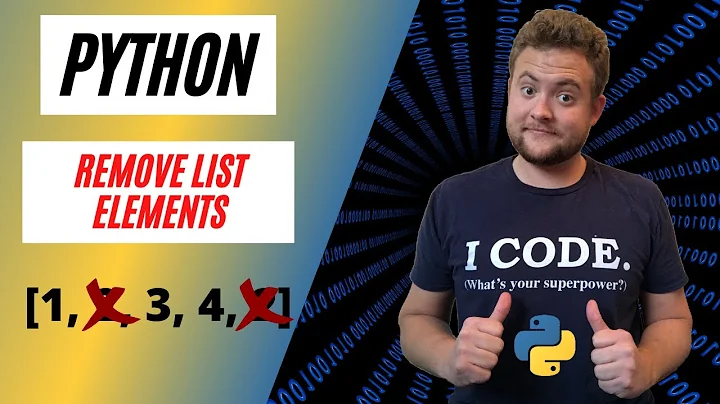Python remove elements that are greater than a threshold from a list
Solution 1
Try using a list comprehension:
>>> a = [1,9,2,10,3,6]
>>> [x for x in a if x <= 5]
[1, 2, 3]
This says, "make a new list of x values where x comes from a but only if x is less than or equal to the threshold 5.
The issue with the enumerate() and pop() approach is that it mutates the list while iterating over it -- somewhat akin to sawing-off a tree limb while your still sitting on the limb. So when (i, x) is (1, 9), the pop(i) changes a to [1,2,10,3,6], but then iteration advances to (2, 10) meaning that the value 2 never gets examined. It falls apart from there.
FWIW, if you need to mutable the list in-place, just reassign it with a slice:
a[:] = [x for x in a if x <= 5]
Hope this helps :-)
Solution 2
You can also use the filter() function along with a lambda function, which could work better for something that is tuple and not just a list.
Regular example
a = [1, 9, 2, 10, 3, 6]
filtered = filter(lambda num: num > 5, a)
print(list(filtered))
Output: [9, 10, 6]
Tuple example
a = [
['Data1', 1],
['Data2', 9],
['Data3', 2],
]
filtered = filter(lambda num: num[1] > 5, a)
print(list(filtered))
Output: [['Data2', 9]]
Related videos on Youtube
Mel
Updated on November 02, 2021Comments
-
Mel over 1 year
I would like to remove elements that are greater than a threshold from a list.
For example, a list with elements
a = [1,9,2,10,3,6].I would like to remove all elements that are greater than 5.
Return should be [1,2,3].
I tried using enumerate and pop but it doesn't work.
for i,x in enumerate(a): if x > 5: a.pop(i)-
 Mark about 3 yearsYou would typically make a new list with something like
Mark about 3 yearsYou would typically make a new list with something likea = [n for n in a if n < 5]
-
-
 Karl Knechtel about 3 yearsBeautiful answer, as expected from a core dev. I often see a lot of resistance to the idea of showing list comprehensions to beginners; but I honestly believe that - with a proper grounding - they are easier to understand (for the tasks where they're appropriate) than the corresponding loop.
Karl Knechtel about 3 yearsBeautiful answer, as expected from a core dev. I often see a lot of resistance to the idea of showing list comprehensions to beginners; but I honestly believe that - with a proper grounding - they are easier to understand (for the tasks where they're appropriate) than the corresponding loop.
![[3 Ways] How to remove element/item from Python list? Difference Between remove, del and pop?](vi/vy0WYVQeGDk/hq720_sqp--oaymwEcCNAFEJQDSFXyq4qpAw4IARUAAIhCGAFwAcABBg---rs-AOn4CLDciq8YRYckLEodoSqNJ8iW1mgSYw.jpg)

